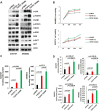FGFR1 is a potential therapeutic target in neuroblastoma
- PMID: 35488346
- PMCID: PMC9052553
- DOI: 10.1186/s12935-022-02587-x
FGFR1 is a potential therapeutic target in neuroblastoma
Abstract
Background: FGFR1 regulates cell-cell adhesion and extracellular matrix architecture and acts as oncogene in several cancers. Potential cancer driver mutations of FGFR1 occur in neuroblastoma (NB), a neural crest-derived pediatric tumor arising in sympathetic nervous system, but so far they have not been studied experimentally. We investigated the driver-oncogene role of FGFR1 and the implication of N546K mutation in therapy-resistance in NB cells.
Methods: Public datasets were used to predict the correlation of FGFR1 expression with NB clinical outcomes. Whole genome sequencing data of 19 paired diagnostic and relapse NB samples were used to find somatic mutations. In NB cell lines, silencing by short hairpin RNA and transient overexpression of FGFR1 were performed to evaluate the effect of the identified mutation by cell growth, invasion and cologenicity assays. HEK293, SHSY5Y and SKNBE2 were selected to investigate subcellular wild-type and mutated protein localization. FGFR1 inhibitor (AZD4547), alone or in combination with PI3K inhibitor (GDC0941), was used to rescue malignant phenotypes induced by overexpression of FGFR1 wild-type and mutated protein.
Results: High FGFR1 expression correlated with low relapse-free survival in two independent NB gene expression datasets. In addition, we found the somatic mutation N546K, the most recurrent point mutation of FGFR1 in all cancers and already reported in NB, in one out of 19 matched primary and recurrent tumors. Loss of FGFR1 function attenuated invasion and cologenicity in NB cells, whereas FGFR1 overexpression enhanced oncogenicity. The overexpression of FGFR1N546K protein showed a higher nuclear localization compared to wild-type protein and increased cellular invasion and cologenicity. Moreover, N546K mutation caused the failure in response to treatment with FGFR1 inhibitor by activation of ERK, STAT3 and AKT pathways. The combination of FGFR1 and PI3K pathway inhibitors was effective in reducing the invasive and colonigenic ability of cells overexpressing FGFR1 mutated protein.
Conclusions: FGFR1 is an actionable driver oncogene in NB and a promising therapy may consist in targeting FGFR1 mutations in patients with therapy-resistant NB.
Keywords: FGFR1; Metastasis; Mutation; Neuroblastoma; Targeted therapy.
© 2022. The Author(s).
Conflict of interest statement
Authors declare no competing interests.
Figures





Similar articles
-
Oncogenic FGFR1 mutation and amplification in common cellular origin in a composite tumor with neuroblastoma and pheochromocytoma.Cancer Sci. 2022 Apr;113(4):1535-1541. doi: 10.1111/cas.15260. Epub 2022 Feb 16. Cancer Sci. 2022. PMID: 34971484 Free PMC article.
-
Deep Sequencing in Conjunction with Expression and Functional Analyses Reveals Activation of FGFR1 in Ewing Sarcoma.Clin Cancer Res. 2015 Nov 1;21(21):4935-46. doi: 10.1158/1078-0432.CCR-14-2744. Epub 2015 Jul 15. Clin Cancer Res. 2015. PMID: 26179511
-
Intelectin 1 suppresses the growth, invasion and metastasis of neuroblastoma cells through up-regulation of N-myc downstream regulated gene 2.Mol Cancer. 2015 Feb 21;14:47. doi: 10.1186/s12943-015-0320-6. Mol Cancer. 2015. PMID: 25889839 Free PMC article.
-
Role of stemness-related molecules in neuroblastoma.Pediatr Res. 2012 Apr;71(4 Pt 2):511-5. doi: 10.1038/pr.2011.54. Epub 2012 Feb 1. Pediatr Res. 2012. PMID: 22430387 Review.
-
Mechanisms involved in selecting and maintaining neuroblastoma cancer stem cell populations, and perspectives for therapeutic targeting.World J Stem Cells. 2021 Jul 26;13(7):685-736. doi: 10.4252/wjsc.v13.i7.685. World J Stem Cells. 2021. PMID: 34367474 Free PMC article. Review.
Cited by
-
A High-Grade Glioma, Not Elsewhere Classified in an Older Adult with Discordant Genetic and Epigenetic Analyses.Biomedicines. 2024 Sep 8;12(9):2042. doi: 10.3390/biomedicines12092042. Biomedicines. 2024. PMID: 39335555 Free PMC article.
-
Potential Cause-and-Effect Relationship between Gut Microbiota and Childhood Neuroblastoma: A Mendelian Randomization Analysis.Indian J Pediatr. 2025 Jul;92(7):717-724. doi: 10.1007/s12098-024-05065-6. Epub 2024 Mar 27. Indian J Pediatr. 2025. PMID: 38536652 Free PMC article.
-
Selective degradation of FGFR1/2 overcomes antiestrogen resistance in ER+ breast cancer with FGFR1/2 alterations.Cancer Lett. 2025 Jun 1;619:217668. doi: 10.1016/j.canlet.2025.217668. Epub 2025 Mar 22. Cancer Lett. 2025. PMID: 40127812
-
Pro-metastatic and mesenchymal gene expression signatures characterize circulating tumor cells of neuroblastoma patients with bone marrow metastases and relapse.Front Oncol. 2022 Sep 13;12:939460. doi: 10.3389/fonc.2022.939460. eCollection 2022. Front Oncol. 2022. PMID: 36176417 Free PMC article.
-
The Non-Coding Regulatory Variant rs2863002 at chr11p11.2 Increases Neuroblastoma Risk by Affecting HSD17B12 Expression and Lipid Metabolism.Adv Sci (Weinh). 2025 Sep;12(33):e15181. doi: 10.1002/advs.202415181. Epub 2025 Jun 17. Adv Sci (Weinh). 2025. PMID: 40525640 Free PMC article.
References
Grants and funding
LinkOut - more resources
Full Text Sources
Miscellaneous

